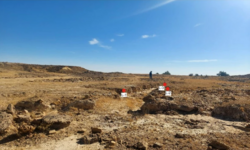Earth:Jaisalmer Formation
| Jaisalmer Formation Stratigraphic range: Middle-Late Jurassic, Bajocian–Oxfordian | |
|---|---|
 An outcrop of the Jaisalmer Formation which is the type locality for Tharosaurus indicus. Photographed between 2019-21. | |
| Type | Geological formation |
| Sub-units | Badabag Member, Fort Member, Hamira Member, Jajiya Member, Joyan Member, Kuldhar Member |
| Underlies | Baisakhi Formation |
| Overlies | Lathi Formation |
| Thickness | Variable, typically 120–170 km (75–106 mi) |
| Lithology | |
| Primary | Siltstone, sandstone |
| Other | Limestone |
| Location | |
| Coordinates | [ ⚑ ] : 26°54′42″N 70°55′23″E / 26.911661°N 70.922928°E |
| Country | |
| Extent | Jaisalmer |
| Type section | |
| Named for | Jaisalmer, India |
| Named by | Richard Dixon Oldham |
| Year defined | 1886[1] |
The Jaisalmer Formation is a Middle to Late Jurassic-aged geologic formation located in India near the city of Jaisalmer that consists mainly of marine deposits.[2] The formation was first identified and defined by geologist Richard Dixon Oldham in 1886.[1]
Dinosaur remains are among the known fossils recovered from this formation.[3]
Sub-units
The Badabag, Fort, Joyan and Hamira members represent the Middle Jurassic Bajocian and Bathonian stages,[2] while the Jajiya and Kuldhar members represent the Middle Jurassic Callovian and the Late Jurassic Oxfordian stages.[2]
The Fort Member is the most extensively studied and consists of fine to medium grain sandstones and oolitic limestones.[4] The Badabag Member consists of intraformational conglomerate and is fossil bearing.[5]
Paleofauna
Ichnofossils
- (?)Bichordites sp. – "Ichnofossils"[6]
- Cytherella indica[7]
- Micropneumatocythere joyanensis[7]
- Planolites .sp – "Ichnofossils"[6]
- Progonocythere khoslai[7]
- Rhizocorallium irregulare – "Ichnofossils"[6]
- Rhizocorallium jenense – "Ichnofossils"[6]
- Taenidium serpentinum – "Ichnofossils"[6]
- Thalassinoides .sp – "Ichnofossils"[6]
- Trichordis minuta[7]
Sharks
- Strophodus jaisalmerensis
- Strophodus indicus[8]
- Strophodus magnus[8]
- Strophodus medius[8]
- Planohybodus sp.[8]
Dinosaurs
- Turiasauria indet. – "Fragmentary tooth"[5]
- Averostra indet. - isolated tooth[9]
- Spinosauridae Indet. - "Pedal ungual phalanx"[10]
- Tharosaurus indicus - a dicraeosaurid sauropod[11]
References
- ↑ 1.0 1.1 Oldham, R.D., (1886). Preliminary note on the geology of northern Jaisalmer. Record Geological Survey of India, 19,157-160.
- ↑ 2.0 2.1 2.2 Ahmad, Faiz; Quasim, Mohammad Adnan; Ahmad, Abul Hasnat Masood (January 2021). "Review for "Microfacies and diagenetic overprints in the limestones of Middle Jurassic Fort Member (Jaisalmer Formation), Western Rajasthan, India: Implications for the depositional environment, cyclicity, and reservoir quality". Geological Journal 56 (1): 130–151. doi:10.1002/gj.3945/v1/review2. http://dx.doi.org/10.1002/gj.3945/v1/review2.
- ↑ Weishampel, David B; et al. (2004). "Dinosaur distribution (Late Cretaceous, Asia)." In: Weishampel, David B.; Dodson, Peter; and Osmólska, Halszka (eds.): The Dinosauria, 2nd, Berkeley: University of California Press. Pp. 593–600. ISBN:0-520-24209-2.
- ↑ Narayanan, K., Subrahmanyan, M., Srinivasan, S., (1961). Geology of Jaisalmer. Unpublished report, Oil and Natural Gas Corporation Dehradun, India.
- ↑ 5.0 5.1 "The first turiasaurian sauropod of India reported from the Middle Jurassic (Bathonian) sediments of Jaisalmer Basin, Rajasthan, India". Neues Jahrbuch für Geologie und Paläontologie - Abhandlungen 304 (2): 187–203. 2022. doi:10.1127/njgpa/2022/1064.
- ↑ 6.0 6.1 6.2 6.3 6.4 6.5 Kulkarni, K.G., Borkar, V.D., Petare, T.J., (2008). Ichnofossils from the Fort Member (Middle Jurassic), Jaisalmer Formation, Rajasthan. Journal of the Geological Society of India, 71, 731-738
- ↑ 7.0 7.1 7.2 7.3 Kumari, M. (2023). "Middle Jurassic Ostracodes from Joyan Member, Jaisalmer Formation, Jaisalmer, Rajasthan, India". Paleontological Journal 57 (7): 775–783. doi:10.1134/S0031030123070055.
- ↑ 8.0 8.1 8.2 8.3 "A small assemblage of marine hybodont sharks from the Bathonian of the Jaisalmer Basin, India". Neues Jahrbuch für Geologie und Paläontologie - Abhandlungen 301 (3): 317–333. 2021. doi:10.1127/njgpa/2021/1014.
- ↑ Sharma, Archana; Hendrickx, Christophe; Singh, Sanjay (2023-01-23). "First Theropod Record from the Marine Bathonian of Jaisalmer Basin, Tethyan Coast of Gondwanan India" (in en). Rivista Italiana di Paleontologia e Stratigrafia 129 (1). doi:10.54103/2039-4942/18306. ISSN 2039-4942. https://riviste.unimi.it/index.php/RIPS/article/view/18306.
- ↑ Sharma, A.; Novas, F. E.; Singh, S. (2023). "First Jurassic evidence of a possible spinosaurid pedal ungual from the Jaisalmer Basin, India". Rivista Italiana di Paleontologia e Stratigrafia 129 (3): 653–670. doi:10.54103/2039-4942/20032. https://riviste.unimi.it/index.php/RIPS/article/view/20032.
- ↑ Bajpai, S.; Datta, D.; Pandey, P.; Ghosh, T.; Kumar, K.; Bhattacharya, D. (2023). "Fossils of the oldest diplodocoid dinosaur suggest India was a major centre for neosauropod radiation". Scientific Reports 13 (1): 12680. doi:10.1038/s41598-023-39759-2. PMID 37542094. Bibcode: 2023NatSR..1312680B.
 |

